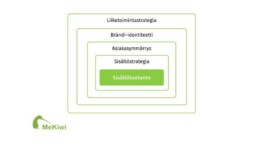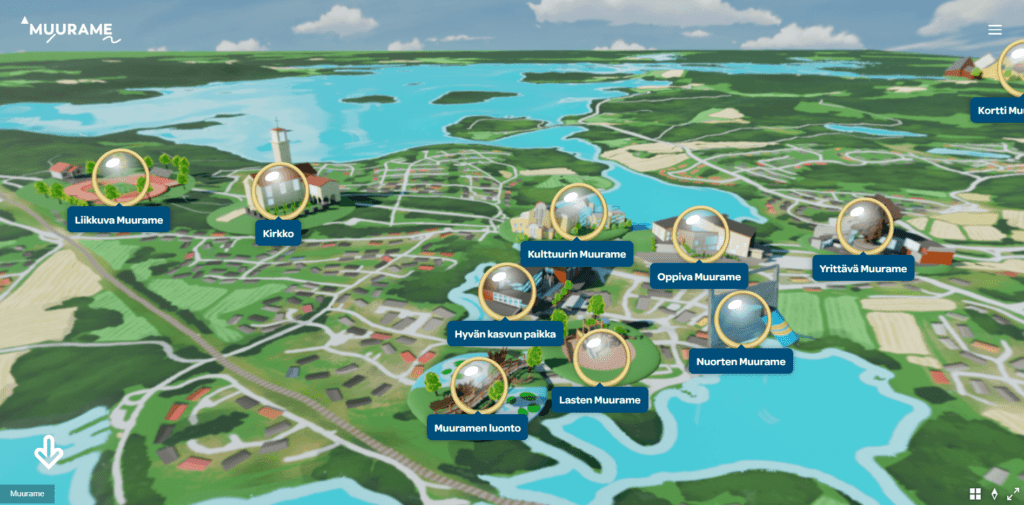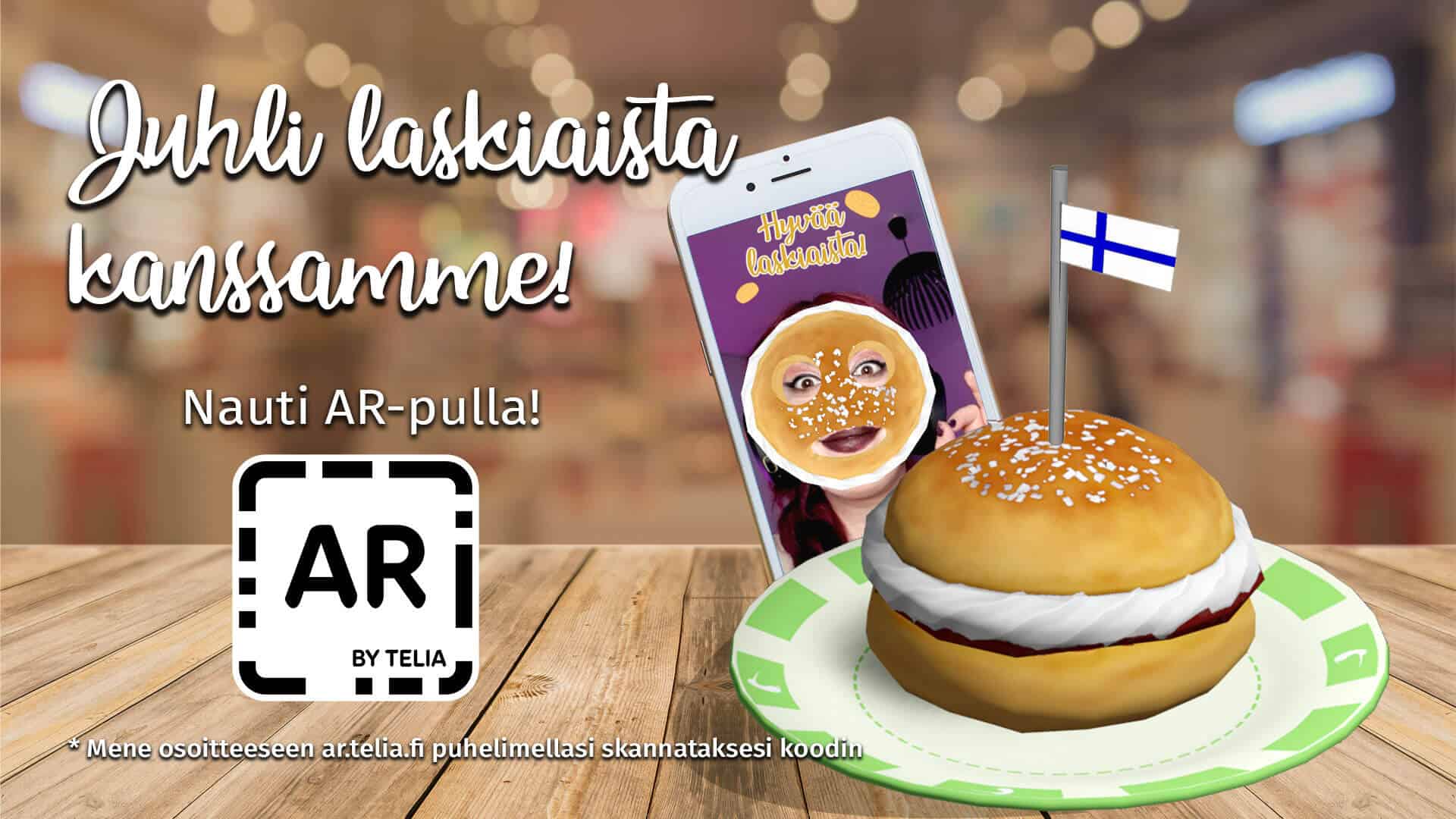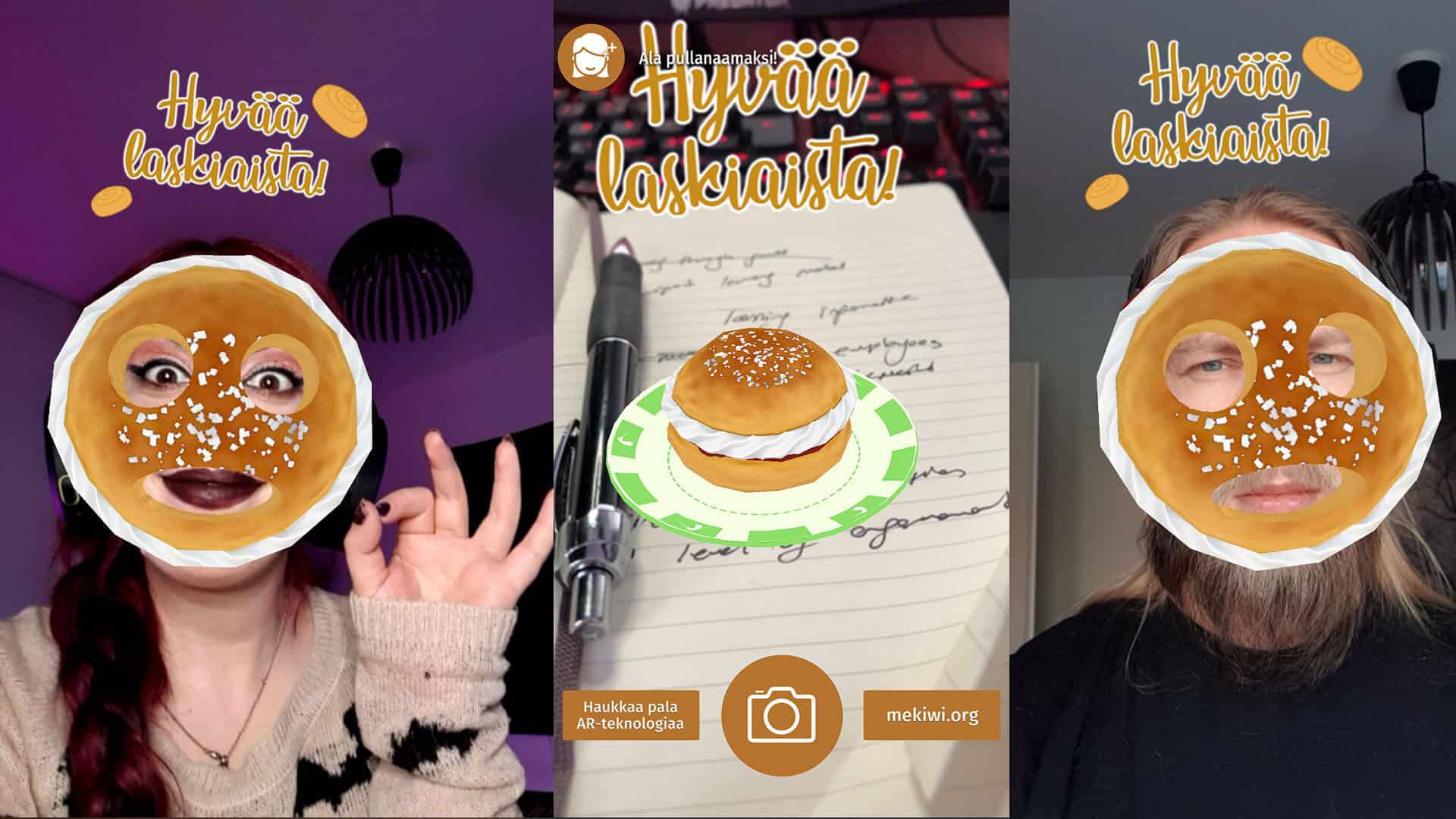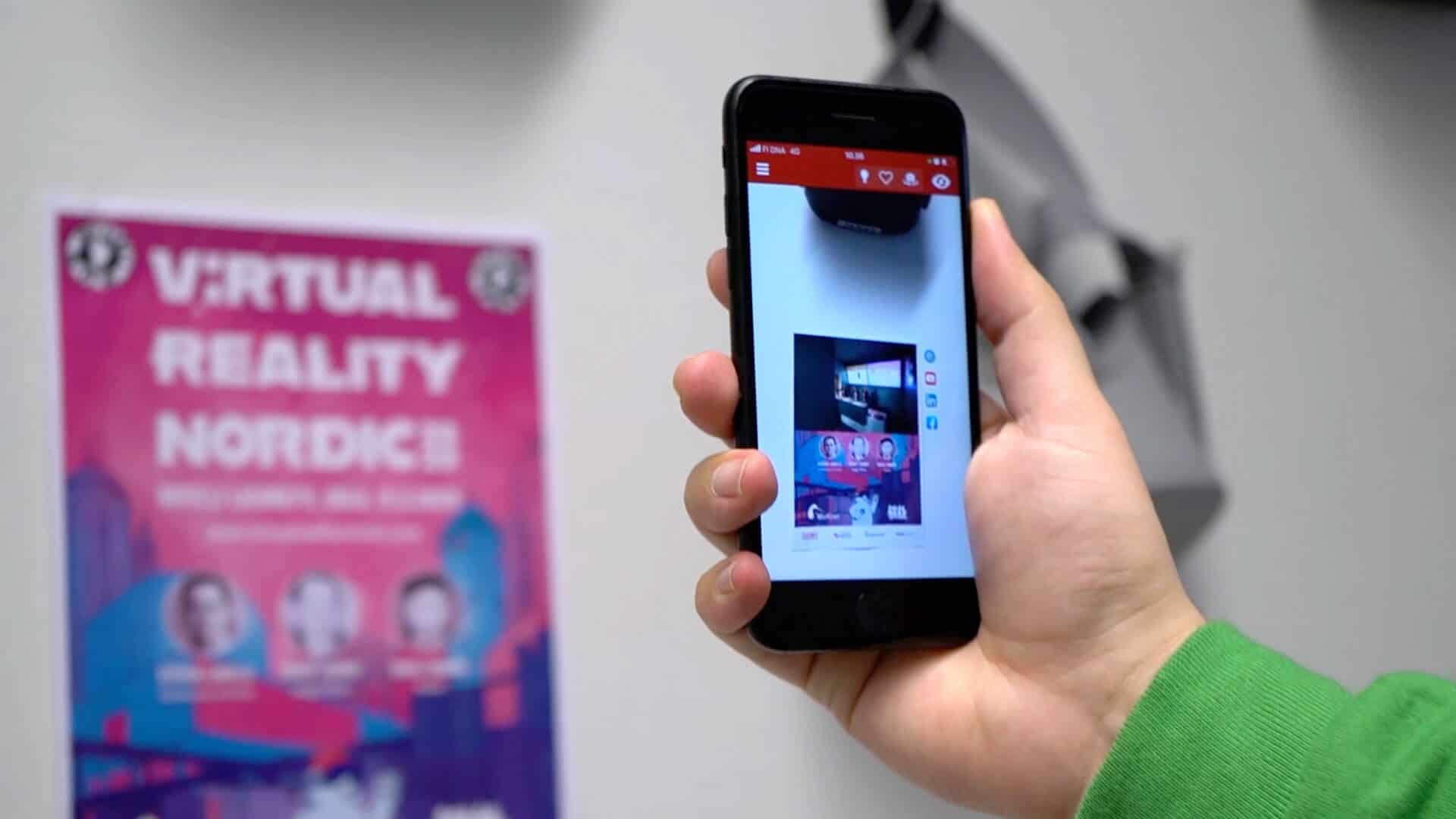Metaverse opens up for business
Game development has brought the virtual world to homes. The digitally native and global Gen Z has grown up with advanced graphics for computer games. Their experience and attitudes set high standards for the virtual user experience.
The Metaverse is the virtual world of the future. It is where people enjoy themselves, buy and work virtually. User simultaneity allows them to interact and communicate with each other in a shared virtual environment.
Metaverse and multisensory experiences
Virtuality creates new kinds of opportunities for business. The Metaverse offers customers a multi-sensory customer experience through virtual, real-time interaction.
Today, virtual reality (VR) in the metaverse is, for example, a commercial VR environment where customers can explore the products and services on offer in 3D showrooms or simulated use cases.
Customers create a virtual character for themselves, which allows them to move and chat with other virtual characters in the same space. The virtual 3D environment and models help the customer to get familiarised with the features of products and services and thus make it easier, for example, to make a purchase decision. A well-designed virtual tour reduces the customer’s product returns and the need for customer service.
VR technologies enabling the metaverse
Virtual applications enable a virtual experience of things, places, and situations that are currently inaccessible.
The goal of a VR application is to create a lifelike, virtual, customer experience, to the extent that it is appropriate. A good example of this is the Simboat VR application developed in collaboration between MeKiwi and XR Marine. The highlights of boating are present virtually, allowing the customer to discover a new boat model even before the ice starts to melt.
The technologies enabling the metaverse are AR (Augmented Reality) and VR (Virtual Reality) and the intermediate form MR (Mixed Reality). They are based on XR (Extended Reality).
In the AR experience, virtual content is connected to the real world with the help of an AR-supported application or browser. A familiar example for many is the Pokémon GO game. In it, the player searches for Pokémon characters that are connected to the real world. Additional information or instructions on a product or service that can be accessed via a QR code is also an AR experience.
In a VR application, the virtual environment is viewed with VR glasses that exclude the outside world. In the environment, you interact with objects manually or with VR controllers. Visuals, sounds, and interactions with the environment create an immersive VR experience.
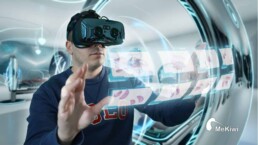
The use of the metaverse is increasing
Hyper-realistic, shared and multi-sensory virtual worlds are on the rise. The most advanced virtual environments are for business and industry. The adoption of Metaverse in the consumer market requires advances in devices, applications, platforms and connectivity.
According to Nashant Batra, Nokia’s Chief Strategy and Technology Officer, the first 5G-Advanced deployments will begin in 2025, when the coverage of the metaverse will increase dramatically. For more detailed technical information, see the guide Metaverse matters: A guide to an immersive future published by Nokia.
The metaverse is implemented by professionals
The aim of the VR experience is to achieve the immersiveness familiar from the gaming world, where the user is immersed in their VR experience. The aim is to create a VR environment in which the operating principles of the real world are reflected. A good example of a VR environment is MeKiwi’s latest VR game, Cave Digger 2: Dig Harder.
A positive user experience is created by skillful technical implementation and smooth service. The best results are achieved by a professionally multi-skilled product development team that includes software developers, graphic designers, UI/UX designers and service designers.
Want to boost your business with virtual reality? As professionals in game development and digital marketing and sales, we can help you make the most of virtual technology.
We will familiarise ourselves with your company’s needs and create an overall picture of the development project for you. We tell you what we do, how we move forward and what we achieve together.
We have been involved in the story of many customers. Check out the references and blogs on our website.
How to improve your website visibility?
You have web pages, but they don’t appear in your browser’s search results. This is a pretty common problem. It is often assumed that the marketing effort has been made once the website has been launched. Websites must be kept alive. They need updating from time to time, e.g. new content and internal and external linking.
How to do SEO?
SEO (Search Engine Optimization) is a process that improves the website visibility in relation to competitors’ ones. Website visibility is affected by the technical functionality of the site, search engine optimized content, company brand awareness, and user personalization. Personalization can be increased, for example, through product suggestions and retargeted advertising to the user of the site. In this blog, we will focus on producing search engine optimized content.

What is search engine optimized content like?
It is worth thinking about what are the strategic customer groups. What kind of customers do you want to market the services to? Who are the potential customers? What kind of needs do they have?
On the other hand, what kind of needs do we have ourselves? What services do we want to provide? What kind of leads do we want to achieve? How are target groups informed about their own values and goals? How would organisations, unions and associations improve the recruitment of new members, for example? Based on these questions, you can already guess what kind of content should be on the website.
In addition to strategy and customer orientation, one of the goals of website design is the visibility of the pages, i.e. search engine optimized content. However, before producing content, you need to find the most common search terms, i.e. keywords.
How to find keywords that work?
Keywords are the very words that customers use to find a solution to their needs. So step into the customer’s shoes yourself and start googling the service you want to find and know about. This allows you to find the best keywords and the most common questions that customers have used when searching for the service.
Customer orientation, natural questions, keywords and linking enhance the findability of the website. Search engine optimised keywords are not just a list of words in the content, they are embedded in the titles and text. The main thing is the clarity and interest of the text from the customer’s point of view.
The most important keyword is the one around which the content is built. Other keywords, on the other hand, support the topic substantially. You can’t fool the search engine, so you shouldn’t overuse keywords. A good ratio is one keyword per 20 words. Services are also often sought with questions. Questions are great keywords. They can be used in content titles. From the keywords you can create the so-called keyword map to help write the rest of the content.
Keywords and content writing
Keyword lists are not yet content, but pages should provide customers with expert and interesting content. It must also be salesy and support the customer’s path to purchase. The website may contain, for example, product information about products, test results and customer quotes about the use of the product. The content of the services includes service descriptions, pictures, maps, customer stories and customer quotes about the service. The sites of organisations etc. provide members with relevant information on their activities.
Whose job, then, is it to produce content? You can entrust content creation to professionals if you don’t have the time and know-how to do so. The professional knows how to write clear, interesting and sales-promoting text. However, you are a service provider and know more about your services than an outsider. Therefore, you should participate in content production as an expert, and provide information and comment on content produced by an outsider.
What is the meta description?
The website is made more interesting by the meta description, i.e. the metatext, which appears as text that describes the content of the web page when the browser’s search results are listed. The aim of the description is to capture your interest and make you want to explore the site in more detail.
The role of meta description is significant, so it is worth investing in it. The description is written in a customer-oriented manner. Let’s think about what a potential customer wants to know and consider the answers to them. The more interesting the description, the more likely it is that the customer will click on the site.
Is your search engine optimization up to date? As digital marketing experts, we can improve the discoverability of your business website.
We get acquainted with the technical implementation of your company’s website and the optimization of services and keywords. We create an overall picture of the development project for you, what we do, how we proceed and what we achieve together.
Read also our previous blog, How do I produce meaningful content?
Want to know more about external links? You can check the MOZ website.
How do I create meaningful content?
Content is always produced for the customer. It needs to reach the right customers and address them in the right way. Business strategy, brand and customer understanding are the cornerstones of content production. They give the content a strategic direction, a way of working and communicating, and create value for the customer. The key to meaningful content production are buyer personas, the purchase paths created for them, timely content and content linking from different channels to websites.
How do I strategically produce the right content?
Content marketing is part of a company’s marketing strategy. In the same way as the marketing strategy and the marketing plan that implements it, the content strategy and content production also follow the business strategy of the company. In this way, the organisation works in harmony towards the goals set.
Strategically, we know, for example, to whom, what, how and where we market and sell. From the perspective of a content strategy, it is meaningful to know what kind of buyer personas we want to reach, engage and serve, and how we manage content in different channels and websites. When content is created around the problems and goals of the buyer persona, sales grow, the brand is strengthened, and our company succeeds.
For the overall brand of the company, it is important that the communication is in line with the brand. The communication of brand identity and value proposition is reflected in all communication, so it should not be forgotten in content production either. The contents consistently reflect the company’s personality, way of working and communicating. Brand should manifest itself in all forms of communication, both visual and spoken content. Consistency of communication increases the credibility of the company in the eyes of the client.

How do I add customer focus to content production?
The better we understand the customer, the easier it is for us to produce content. Customer research provides valuable information for defining buyer personas and the factors that guide a purchase decision. The goal of customer orientation is to create value for the customer with every channel and content. Well-executed content is interesting, informative and motivating for the customer and supports the purchasing process. They also improve the interaction and cooperation between the customer and the company.
The content creator is particularly interested in the customers’ purchasing and service experiences. Purchasing services requires expertise and is often challenging for the customer. Customer satisfaction and efficient and profitable sales are best realised when the customer’s purchase path and the company’s sales path go hand in hand. The client is provided with useful content in a timely manner at different stages of the purchase path.
Customers can be provided with more relevant content that facilitates and speeds up the buying process. For example, a website can create a unique purchase path for each buyer persona. At the beginning of the customer’s purchase path, the task of content production is to support the findability of the website and the intelligibility of the content of the service descriptions. Content linking and search engine optimised content help the customer find the company’s services. The content of the website should provide information and support the customer in the purchase process. Meaningful content entices the customer to progress from one content to another and leads the customer towards a purchase decision.
Is your content creation relevant? At MeKiwi, we use service design to study customer experience and develop the digital purchase path. As digital marketing experts, we can help your company develop content production. We look at your company’s goals and needs. We create an overall picture of the development project for you, what we do, how we proceed and what we achieve together.
5 Things You Didn’t Know Were Gamified
Gamification is rather a new concept that carries great importance in almost every field today. Especially in marketing strategies, gamification is one of the preferred ways to capture the attention of the audience.
Gamification consists of gaming elements integrated into a non-gaming environment. The reason for this incorporation is to increase the engagement level of the users. If you are wondering about these gaming elements, you can read our previous blog post about the topic here.
In this blog, we present the top 5 examples of gamification that you might not have thought about before. The examples will be categorized according to their level and how fast you can spot the gamification strategies used. Let’s start with an easy one!
Easy
Duolingo
Learning a new language might be an interest for many people at some point. One of the easiest ways to start learning a new language is online learning software because everyone can have access to them easily and they are mostly free! Therefore, the first example comes from one of the most popular language learning apps out there: Duolingo.
And, how does Duolingo use the game elements? Here are all the obvious gamified features that are used which makes it an easily distinguished example:
-
- It uses a level system: The lessons are divided into different levels and titles. The user can go to the next level only when the previous ones are completed or they can be skipped if the user is showing good performance on the level. At each level, there are no extreme differences in the difficulty level. There are 3 or 4 new words or phrases introduced in each level. Thus, the competency is neither too easy nor too difficult which can keep the motivation of the user at an optimal level.
- Reward system: In this specific software, users can collect rewards after completing a lesson. Opening a treasure chest can help users to collect in-app gems and some potions for x2 XP. These gems can buy the “streak freezers”, and “extra lives” in the app. This is a great example of engaging the user with the platform.
- Collecting badges: The user becomes more engaged and motivated to use the app more with the rewards, and that helps them to complete more lessons. After completing the lessons, the user can collect badges. Also, the earned badges are shown in the public profile of users. That is an excellent motivation source! Moreover, the app works to build a community by telling the users how many people are learning the same language at the same time. These sentences motivate the user and increase the community feeling.
- Streak: Showing the streak to the user and counting the consecutive days the app has been used is a great way to encourage them to continue using the app. When the user comes to the streak milestone, the software gives rewards such as giving a free trial of the premium version of the game for a couple of days. Also, the app gives some statistical information about the users who played regularly. For example, “Users who complete XX days in a streak are XX% more likely to complete the course!” These types of sentences are a great source of encouragement for the users.
Duolingo is a great example of gamification because of all the elements that are listed above. These elements keep the user encouraged, engaged and motivated. This way, users can learn in a fun way, and keep coming back to use the app!

Medium
Have you ever collected some in-app points to get some reward such as a free product? Or collected mile points to get a discount on your next flight on your most preferred airline? If your answer is yes, you already have experienced and used this level of gamified application! Medium-level gamified applications can be distinguished by some less obvious features. For example, using fidelity points or cards and loyalty points. Here are 2 examples in this matter:
Yelp
Yelp is a software that can be used via its website or apps. The main purpose of the app is to leave reviews, ratings, and photos of the businesses that the users visit. Also, there is a friends list in this app like Facebook. So, what kind of gamification elements do this app use?
-
- Elite status: Who would not like to feel special? Yelp gives this special feeling to its users! If they give frequent reviews, answer questions, and participate in the Yelp community they can have elite status. As it can be seen, this can keep users more active in the app.
Starbucks
Starbucks is also using a Reward app to keep customers purchasing their products. This app is an excellent example of gamification used in real life.
-
- Collecting stars: The user accumulates stars with every product they purchase in this app. Also, the graphical design makes it fun; the stars look like cups and you can fill the cups! The more purchases are made, the more benefits the user earns. These benefits can be a birthday gift or an extra cup of coffee. Who would not like to have these fun and diverse benefits while sipping on their favorite coffee?

Hard
In the following cases, the game elements are more subtle and difficult to find. Therefore, you may have not noticed these great examples of gamification!
Linkedin profiles
When signing up for LinkedIn, the steps that the user should follow to complete the profile are given in the beginning. LinkedIn is a platform to reach out to more people and widen the network to find more job opportunities. Therefore, LinkedIn shows a progress bar in the beginning as you are setting your profile. The more your progress bar is full, the easier it is to reach more people. This is a smart gamified application.
Tinder is also using the same method to make its users complete their profiles. So, if you want to reach more people outside of working hours, you can try Tinder and see its gamification!
Nike+ Run Club
Through the power of community, Nike+ Run Club is connecting people. Nike increases user retention by providing the opportunity to create a supportive community. Users can have this community by comparing the steps taken and distances run with other users of the app. This competitive feeling helps people to connect to other users and be more motivated. This is an excellent example of gamification because, with this app, users can customize their training program, and complete the challenges to win badges and trophies.

Honorable Mention
Finally, as an honorable mention, we would like to present an amazing real-life gamification example. Gamification does not have to be only in the digital world. Moreover, just because it includes game elements, it also does not mean gamification or games are only for younger people. Here, we can also highlight the fact that playfulness is a major factor in games in general as it can be seen in this specific example. Therefore, anything gamified should be fun, and the fun can come from even only being playful! The initial aim was to encourage people to use the stairs instead of the escalator to fight obesity. The research shows that after the stairs were turned into piano keys, people preferred stairs to escalators!
Why use gamification?
In our previous post, we have explained the gamification concept. The post can be read here. However, let’s quickly reintroduce what is gamification. In short, gamification is the application of elements of game playing to different areas of activity. This is usually seen as an online marketing technique to engage with a service or a product. However, it is essential to remember that gamification is not the game itself but the use of game elements in non-gaming functions and circumstances. Especially in the last decade, gamification has become a hot topic both in education and in business. With this blog, we aim to delve into the gamification concept.
Why using gamification?
The fact that traditional motivational elements, such as curiosity and adding personal challenge, are no longer valid in today’s world is emphasized in business and personal development books. This is also proven by scientific research. Gamification of any element creates an internal trigger by changing the perception of the feature, making it more attractive. The point that definitely should be highlighted about gamification as a concept is that the majority of people play games just because they want to play. Thus, people play games of their own free will, and especially the younger generation spends time on games equal to their weekly working hours. Therefore, to grab the attention of your customers or your students, it is crucial to gamify the elements of the topic concerned.
The concept of gamification became popular as the growing game industry showed that games have a powerful effect on human motivation. Before this concept officially emerged, some workplaces already used practices with game mechanics: for example, choosing the best employee of the month to keep the employees engaged and motivated. Therefore, adding game elements to introduce competition is a great use of gamification in business. Moreover, this concept is highly useful for educational purposes and research shows that it has a positive impact on learners’ motivation and engagement.
Which gamification elements can you add to your apps & learning environment?
Gamification is a popular keyword, especially in the education sector. Moreover, learning apps as learning environments are very popular. You might then be wondering what types of game elements you should include in your apps and learning environment. We would like to answer this question with the following list of elements:
- Level, points, scores
- Progress bars
- Rewards and badges
- Storylines
- Countdowns and schedule
- Personalization
- Leaderboards
- In-app tools
- Micro-interactions
All the elements listed above are aiming to increase competitiveness and keep the users motivated and engaged with the product. Therefore, if gamification is included, the possibility of users’ keep coming back and using the app is more likely than ever. Moreover, gamification and game elements can be included in everything that can be thought of. The researches also show that gamified training in workplaces keeps the employees engaged and reduces boredom during training. It is very important to realise what is popular and preferred by the users, especially these days. Therefore, including the best-known game elements in the apps and learning environment would give you a great advantage.
Best practices for retaining users with game elements
As it was mentioned previously, the main reason for gamification is to keep the users retained, engaged, and motivated. There are some specific gamified solutions and practices that increase user engagement.
Let’s get into the details! Here’s a list of 4 practical examples:
- Tutorial: Tutorials teach the user how the game works, making it easier to engage with. However, it is important to not make the tutorial too long, complicated, or too simple. By tracking whether a user skips certain parts of the tutorial, you can get an estimate for the right tutorial features.
- Reward: Adding daily rewards will keep the user coming back to the app every day to collect them. Moreover, giving rewards after an achievement also motivates and encourages the user to keep coming back to the app.
- Notifications: Using push notifications is again encouraging the user to keep using the app or the game.
- Providing the chance to have a community: for example, setting options such as “invite a friend” or “ask a friend to send a heart” creates a sense of companionship or competition. When the users feel like they have a virtual community on the app, it will help them use the app instead of dropping out.
These practices are all part of the traditional gamification approach. However, it is worth mentioning that trends and circumstances rapidly evolve and change. Nowadays, many apps look for different ways to increase retention because users usually avoid push notifications. Moreover, inviting friends through Facebook is also seen as a fading trend. Therefore, even though these practices are considered some of the best to retain users, it is important to keep a dynamic approach and check what solutions users themselves are gravitating towards.
The advantages of implementing gamified solutions
Gamification has become very popular in the last decade because it has a lot of advantages. Moreover, there are so many benefits of why gamification is worth using in learning apps or solutions. The statistics from the research also prove that when gamification is used learning is more effective. Here are the best advantages of implementing gamified elements, especially for e-learning solutions:
- Increases the engagement
- Improves the motivation of the users
- Helps and improves retaining knowledge
- Elevates cognitive development
- Helps education to become more accessible
You may have more questions about gamification, and you can contact MeKiwi to have your answers! As MeKiwi, we are providing services to build custom-made gamified solutions to your needs in the business and education fields. Do you want to make your product digitally engaging and motivating? Let us do it for you!
Do not hesitate to contact us for more information and the best digital gamified solutions.
How the travel industry can benefit from XR technology
You may be familiar with XR technology and how it is used in the gaming sector, but many other industries can also benefit from it. In this blog we briefly concentrate on how the travel industry can utilize XR.
What does XR mean?
Extended Reality (XR) is a term that refers to all the immersive technologies, such as virtual reality (VR), augmented reality (AR), and Mixed Reality (MR).
Digital visibility is vital to companies and what could be better than XR technology and its endless possibilities and scalability. Utilizing XR technology also gives the company a competitive edge on social media by creating more interesting content for the visitor. Especially after corona restrictions, we had to adapt to a “new normal”, which inevitably increases XR technology and virtuality in general.
XR technology and travelling
XR technology can be used, for example, in the marketing of a travel destination. Many travelers search a lot in advance about different travel destinations and their attractions and activities. In this case, marketers can create a 360° video of the destination that the end user can view even in their own living room. When an user has better and more extensive access to exploring their destination in advance, they are much more likely to book that trip, compared to a trip or destination where there is not enough information available. The traveler can navigate the desired route or attractions in advance, which will save them time. This also helps the traveler to choose the right destination for them and helps to plan the trip, for example, in terms of equipment. In addition to the destination itself, the accommodation/hotel can be marketed as well.
Virtual tours could also be created especially when traveling to a destination is physically inconvenient or otherwise restricted. With XR technology, the visitor gets much more out of the trip, they can explore more destinations or focus on one more intensively. Thanks to the latest technology, virtual travel destinations or virtual elements embedded in the physical world are even more immersive.
Technology in the middle of nature and in the city
XR technology can be utilized both on nature trails and in the middle of the city. In both cases, the XR can be used to provide information about the environment to the user, whether it is a type of tree or animal species or, for example, a statue or some other area or object.
For example, a user can scan a statue or even a QR code using their own phone to display information about that place on their phone screen, by text, video or an audio track, all of these can be combined as well. How does it sound to view a place through the eyes of history? You are physically present in a modern environment and at the same time you can view how that area looked like a long time ago.
MeKiwi has developed many extended reality projects. For example, the Digimuurame.fi multimedia website that MeKiwi created for the municipality of Muurame allows users to visit the Muurame Church, listen to the choir in an augmented reality, or even go on an adventure with a canoe and mountain bike in Muurame’s nature via 360° video experience. MeKiwi has also implemented an AR application called “Oulujoen ympäriajo” for a thrilling orienteering experience in cooperation with Oulujoki School’s students and teachers. Among other things, the app helps promoting student participation and creativity.
From an idea to the solution
In April 2022, Business Finland organized a funding application to support sustainable growth and digitalisation in traveling, which implements Finland’s Sustainable Growth Program, which aims to build a greener and more digital society. The purpose was to highlight how to make a tourist stay longer, the year-round tourism and traveling and new customer groups. XR solutions can meet these needs.
If XR technology was a previously unknown topic, you can read more on MeKiwi’s website and contact our account manager Jonna Ranta or our XR expert Merih Arikkök.
SEO trends 2021
Certain trends can be followed both in clothing and websites, but this time we will focus on websites and more specifically on search engine optimization (SEO) 2021 trends.
Mobile friendliness
Today, almost everyone owns a smartphone, which means that websites are also browsed a lot via the phone. In the spring of 2021, Google announced a new algorithm change that will rank mobile-friendly sites higher. So when building a website, it is especially important to make it responsive and functional on all devices.
Create video content
Google searches are also performed as voice searches. Thus, keywords and phrases embedded in videos can improve the video itself or the website to be found on Google if the video is embedded on a site. As with site text content design, video design should take into account your target audience and the types of searches they may do. It’s also worth noting that when speaking, key phrases tend to be longer than keywords placed on web pages, because in general, speech is much more relaxed and there may be a difference in sentence formation when talking vs. doing a Google search.
Put the reader first
One SEO trend that is unlikely to ever go away is that when designing content, write the content for a person and not for a search engine. Text should be clearly written and clear should also be the overall layout of the site, as it assures the visitor to stay on the site longer, which Google also appreciates.
Google SMITH algorithm
In short, Google’s SMITH algorithm is able to understand long sets of text compared to the BERT algorithm, which only understands words and short sentences from short sets of text. That is, in the future, SMITH will help Google index better the most relevant search results for the user.
At MeKiwi, creating responsive and search engine-friendly websites is commonplace, so contact us today and let's take a look at your website needs, whether it’s a small update or a complete overhaul. You can contact Jonna here.
Augmented reality Christmas window
In cooperation with the City of Oulu and the Oulu Chamber of Commerce, MeKiwi created an augmented reality (AR) experience with a Tiernapoika theme in the center of Oulu. Christmas window will be on view from 3rd of December 2021 to 6th of January 2022 in front of the Oulu10 office at Saaristonkatu 8.
Test the Christmas window live by scanning the QR code from the window or visit mekiwi.org/jouluikkuna and scan the Tiernapojat on the window.
You can also test the Christmas window on a small scale remotely directly from this screen by going to mekiwi.org/jouluikkuna on your phone and scanning the Tiernapojat from the image below. So if your location is other than Oulu, no worries, test the AR Christmas window remotely!
MeKiwi wishes you a Merry Christmas!

What does Augmented Reality (AR) mean and what is an AR experience?
Augmented reality, best known as AR, is more common than you think.
You’ve probably tried it at least once without noticing, because AR has been one of the rising trends in technology since 2017! The most common examples of AR are the Snapchat and Instagram face filters that most of us have tried at least once.
If you feel like you aren't familiar with it yet don’t worry, as we’ve put together a short and helpful explanation of what augmented reality (AR) is, how it works, and how it differs from virtual reality (VR); and most importantly, how your business or school can benefit from AR technology!
What does augmented reality (AR) mean?
AR is short for Augmented Reality which is the software technology that expands our physical world by adding digital items into it. Unlike Virtual Reality (VR), it does not create a whole new digital world but integrates digitally created content into our existing environment.
You can directly see the augmented reality in action in an existing environment, such as a digital dragon flying in your living room. Unlike virtual reality (VR), you can access augmented reality (AR) content without wearing an headset. AR can be displayed on various devices: screens, glasses, handheld devices, head-mounted displays and mobile phones – which makes it accessible for almost anyone, anywhere as long as there is a mobile device.
What's the difference between VR and AR?
Augmented Reality (AR) is a technology that brings and connects computer-generated, 3D-designed objects to your real world. Virtual reality (VR) consists of a fully computer-generated virtual world where the user can experience a completely immersive virtual experience.
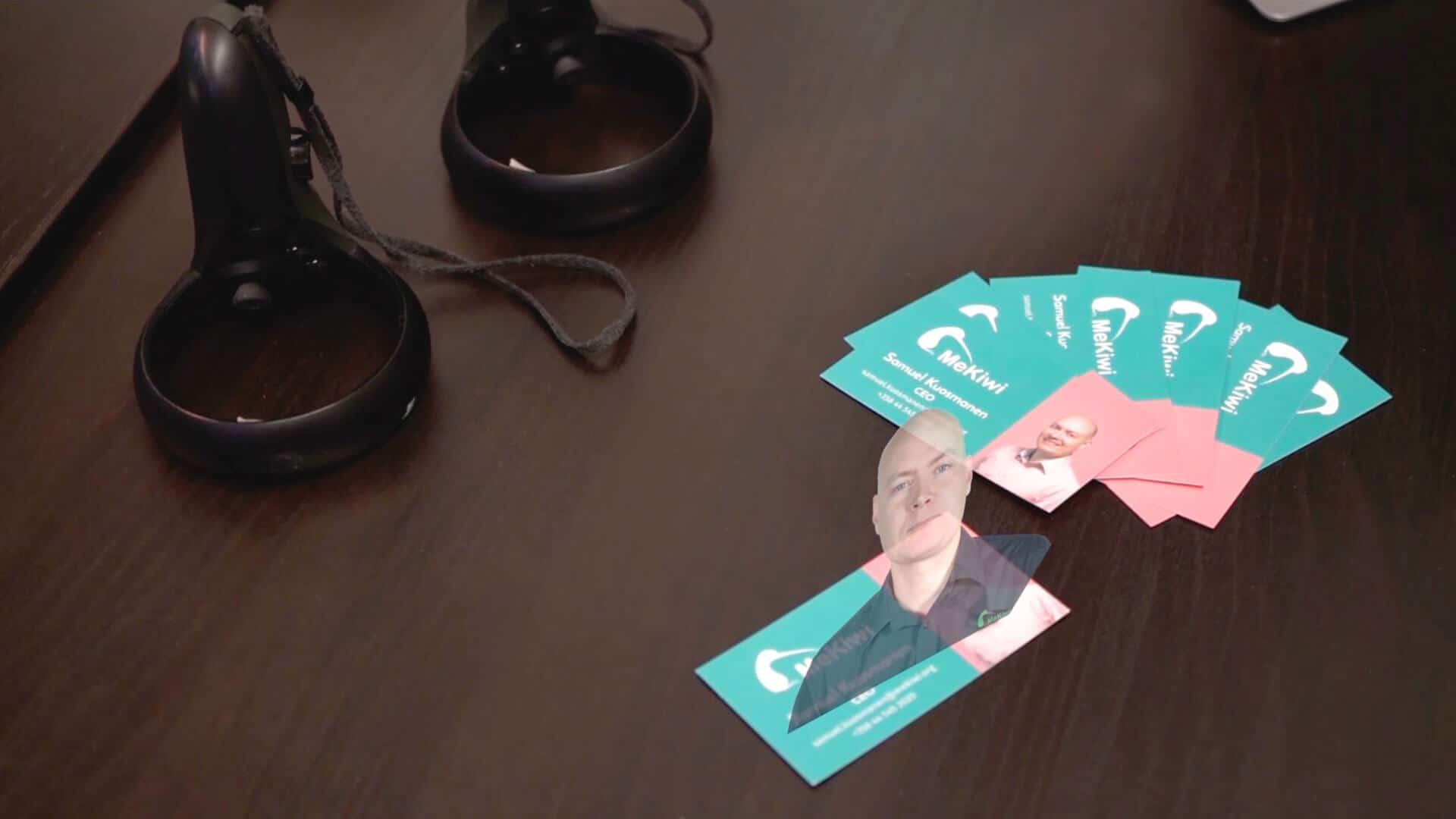
Is Augmented Reality (AR) really the future?
No, it is the present and the future. We all use augmented reality one way or another. All the face filters you can use with your phone are part of the augmented reality. When you buy a new sofa from an online store and you can test what it would look like in your living room, that is also augmented reality.
How Can I Use Augmented Reality (AR) In my Business?
Thanks to its compatibility and ability to run on mobile devices, you can integrate AR virtually anywhere in your business. The biggest advantage is that you do not necessarily need to download a separate app, WebAR works directly in your browser. The consumer clicks a button or goes to your website to start the AR experience.
Examples of how to use AR:
- Product catalogs: Digital or printed product catalogs. With augmented reality, consumers can place your product digitally in their own environment and check them with 3D models.
- Storytelling: Want to tell the story of your 200-year-old restaurant? Or maybe the tale of a medieval town? You can bring your story to life by creating interactive augmented reality content and lead the reader on this journey. Augmented reality makes cultural experiences unique and memorable.
- Online stores: With the touch of a button, users can place 3D models of products on the kitchen table, watch product videos or ask questions.
- Events: Create digitally interactive event posters that allow visitors to experience augmented reality using their phone’s camera.
- Tourism: useful information on destinations, sightseeing attractions, navigation, and directions.
- Buildings: Provide visitors with information and digital content, directions and promotional materials. Can be utilized, for example, in hospitals, shopping malls and stadiums.
- Product brochures: Offer product information, troubleshooting assistance and pre-purchase experience through augmented reality (AR) applications.
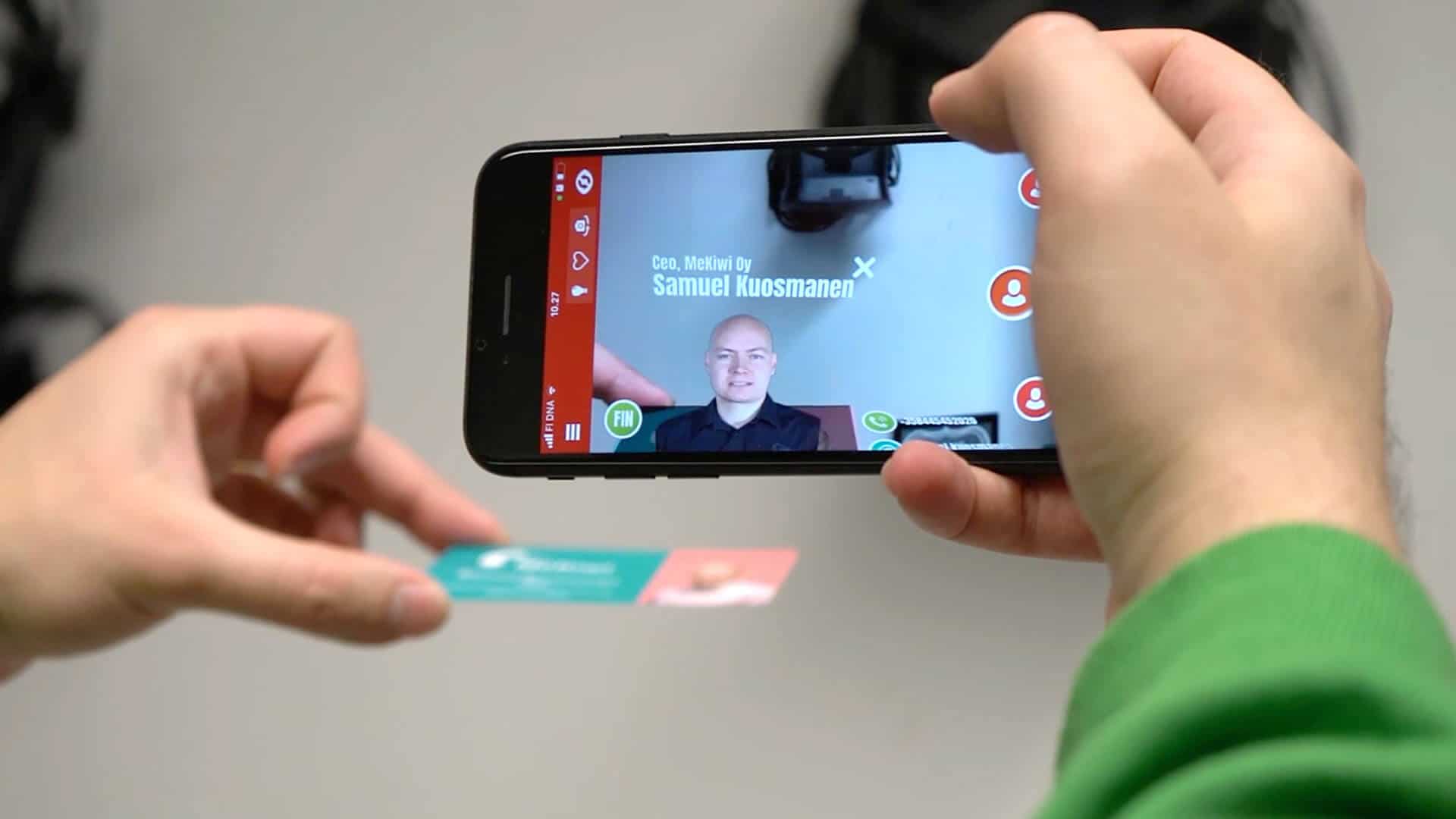
MeKiwi can help you design and implement interactive, memorable and relevant augmented reality (AR) experiences that add value to your brand. Augmented reality solutions allow brands to improve their visibility, build loyalty, engage and increase sales as needed.
Need ideas on how to use AR technology for your business?
Contact our AR expert, tai soita 0447510096.
MeKiwi raised 400 000€ funding for the development of the virtual reality unit
The goal is to develop Finland's largest VR game and grow the B2B VR business
MeKiwi, an Oulu-based digital agency and developer and publisher of virtual reality games, or VR games, recently raised 400 000€ funding to grow their VR business. The goal is to start developing the largest VR game made so far with domestic work and to strengthen the B2B business of the virtual reality unit.
One of the major investors of the total funding of 400 000€ was a Finnish family company Rela Invest Oy. Joonas Pöllä, CEO of the investment company, commented: “The reason we invested in MeKiwi was due to their excellent success with the release of the first VR game. We believe that virtual reality is the next big thing in technology, and the MeKiwi team convinced us with their expertise”. The funding will strengthen MeKiwi's virtual reality unit and VR game production together with the VR game publishing business.

MeKiwi's publishing studio VRKiwi is responsible for developing Finland's largest VR game. Cave Digger 2: Dig Harder, is expected to arrive on the largest digital distribution platform for PC games on Steam next year as a so-called Early Access version. The game will later be published on PlayStation and Oculus Quest, which Facebook bought.
The game is a sequel to MeKiwi's first VR game, Cave Digger, which also has a flat screen game version for players without VR devices. To date, Cave Digger games have sold nearly 50 000 units, which is a respectable number in the still relatively small VR game market of the 2018-19. Now the growth will be pursued with a product whose design focuses on the new generation of VR headsets. “Last year, the first fully wireless standalone device, the Oculus Quest, was launched, which the user no longer needs to plug into anything,” says Jani Kaipainen, MeKiwi's Director of VR Production. "This made the price of the system more than half as cheap as previous computer plus VR headset systems."

“With the release of Oculus Quest, there has been a clear increase in the total number of users of the devices. In 2019, about 4.3 million new headsets were delivered (excluding VR devices for mobile use),according to reports from trend following agencies, and this year the Covid-19 situation has also increased demand for VR devices,” Jani Kaipainen continues.
“Maybe it is because people are looking for new ways to spend time at home and they then decide to try VR headsets, now that their approachability has improved significantly with Quest. In addition, Facebook recently released a new second-generation Quest (Oculus Quest 2)that improves on its predecessor in every area.”
The company has also said that they already have the first two release agreements agreed with two international VR game studios. “The VR market in general and from our point of view looks better than ever before in my work history,” concludes Jani Kaipainen.
More information:
Jani Kaipainen, VR Producer




